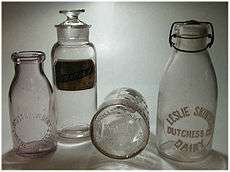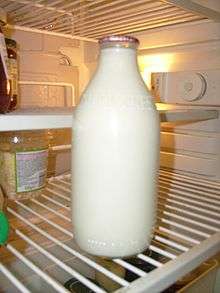Milk bottle

Milk bottles are bottles used for milk. They may be reusable glass bottles used mainly for doorstep delivery of fresh milk by milkmen. Customers are expected to rinse the empty bottles and leave on the doorstep for collection. The standard size of a bottle varies with location; common sizes are 1 pint or 1 quart, although cream may be delivered in smaller bottles.
More recently, plastic bottles have been commonly used for milk. These are often made of high-density polyethylene (HDPE), are used only once, and are easily recycleable.
History


Before milk bottles, milkmen filled the customers' jugs. For many collectors, milk bottles carry a nostalgic quality of a bygone age. The most prized milk bottles are embossed or pyroglazed (painted) with names of dairies on them, which were used for home delivery of milk so that the milk bottles could find their way back to their respective dairies.
It is not clear when the first milk bottles came into use. However, the New York Dairy Company is credited with having the first factory that produced milk bottles, and one of the first patents for a milk container was held by the Lester Milk Jar.[1] There are many other similar milk containers from around this period, including the Mackworh Pure Jersey Cream crockery type jar, the Manorfield Stock Farm, the Manor, the Pa glass wide mouth jar, and the Tuthill's Dairy Unionville, NY.
Lewis P. Whiteman holds the first patent for a glass milk bottle with a small glass lid and a tin clip.[2] The next earliest patent is for a milk bottle with a dome-type tin cap and was granted September 23, 1884 to Whitemen's brother, Abram V. Whiteman.[3] This bottle has been found with cream line marks and is very valuable. The Whiteman brothers produced milk bottles based on these specifications at the Warren Glass Works Company in Cumberland, Maryland and sold them through their New York sales office.
The Original Thatcher is one of the most desirable milk bottles for collectors. The patent for the glass dome lid is dated April 27, 1886. There are several variations of this early milk bottle and many reproductions. During this time period, many types of bottles were being used to hold and distribute milk. These include a pop bottle type with a wire clamp, used by the Chicago Sterilized Milk Company, Sweet Clover, and others. Fruit jars were also used, but only the Cohansey Glass Manufacturing plant made them with dairy names embossed on them.
The Commonsense Milk Bottle with the first cap seat was developed as an economical means for sealing a reusable milk bottle by the Thatcher Manufacturing Company around 1900. Most bottles produced after this time have a cap seat.
By the 1920s, glass milk bottles had become the norm in the UK after slowly being introduced from the US before World War I.[4]
Milk bottles before the 1930s were round. In 1935, slender-neck bottles were introduced in the UK.[4] In the 1940s, a square squat bottle became the more popular style. Milk bottles since the 1930s have used pyroglaze or ACL (Applied Color Label) to identify the bottles. Before the 1930s, names were embossed on milk bottles using a slug plate. The name was impressed on the slug plate, then the plate was inserted into the mold used to make the bottle – the result was the embossed name on the bottle. In 1980 a new bottle, nicknamed "dumpy," was introduced in the UK where it remains the standard now.[4]
From the 1960s onward in the United States, with improvements in shipping and storage materials, glass bottles have almost completely been replaced with either LDPE coated paper cartons or recyclable HDPE plastic containers (such as square milk jugs), depending on the brand. These paper and plastic containers are lighter, cheaper and safer to both manufacture and ship to consumers.[5]
In 1975, 94% of milk in the UK was in glass bottles, but as of 2012 this number was down to 4%.[4]
However, there are growing concerns among some Americans as to the quality and safety of industrialized milk, and the local, non-homogenized milk industry has seen a popular resurgence in certain markets in the US in the last decade or so. Because of this, the use of glass bottles in local or regional, non-industrial milk distribution has become an increasingly common sight.[6]
Chronology
- 1878 – George Lester patents a glass milk container in New York.
- 1880 – British milk bottles were first produced by the Express Dairy Company. They were delivered by horse-drawn carts and delivered four times a day. The first bottles used a porcelain stopper top held on by wire. Lewis Whiteman patents the glass milk bottle with a glass lid.
- 1894 – Anthony Hailwood developed a pasteurisation process for milk which allowed it to be sterilized and be safely stored for longer periods. Milk could now be delivered once a day.
- 1920 – Advertisements began to appear on milk bottles. A sand-blasting technique was used to etch them on the glass.
- 1930s – Increased prevalence of battery electric vehicles as milk floats[7]
- mid 1950s – Cardboard tops were deemed unhygienic and banned in some locations. Delivery by horse-drawn carts was still common.
- early 1990s – The advertising largely disappeared with the introduction of infrared bottle scanners designed to check cleanliness.
Present day
In some locations around the world, different colored tops on milk bottles indicate the fat content. Unpasteurized is often green-topped. However other colour designations may be used by some dairies. Bottles may also be marked, stamped or embossed with the name of the dairy.
In the United Kingdom, the aluminium foil tops on glass milk bottles are normally coloured:
| Colour | Meaning |
|---|---|
| Gold | Channel Island milk |
| Silver | Whole milk (unhomogenized) |
| Red | Homogenized whole milk |
| Red & Silver stripe | Semi-skimmed milk |
| Dark Blue & Silver stripe | Skimmed milk |
| Orange | 1% Fat milk |
| Light Blue | Organic Whole Milk |
| Green | Organic Semi-skimmed milk |
| Green & Silver stripe | Organic Skimmed milk |
Modern dairies may also use refillable plastic bottles, as well as plastic bottle tops. The colour coding for plastic milk bottle tops can be different from that of glass bottles. In the United Kingdom, the plastic tops on plastic milk bottles are normally coloured:
| Colour | Meaning |
|---|---|
| Gold | Channel Island milk |
| Blue | Homogenized whole milk |
| Green | Semi-skimmed milk |
| Red | Skimmed milk |
| Orange | 1% Fat milk |
In the United Kingdom, milk sold to the door is mainly measured in Imperial pints (but labelled 568ml), because the glass bottles are 'returnable', which means they were excluded from metrication. However, Sterilized milk sold to the door is in 500ml glass bottles (and is 'non-returnable' and has colour coded lids that match the colour codes normally seen on plastic bottles). Often, in supermarkets they are sold in pints but labelled with their metric equivalent (568ml). Quantities larger than a pint are generally sold in metric units or multiples of a pint.
With lesser milk consumption, milk in Hong Kong is sold in both glass and plastic bottles as well as in cartons. The glass milk bottles are sold in supermarkets, convenience stores and in small restaurants. The glass milk bottle carries a deposit of 1 Hong Kong dollar. Most commonly available in the market in glass milk bottles are Kowloon Dairy and Trappist Dairy with different shaped glass milk bottles with both in school bottle size.
Orange juice and other fruit juices are also sold in doorstep deliveries in the same style of bottle used for milk. Typically these have an aluminium foil top colour coded to indicate the flavour.
In some countries (e.g. Estonia and some provinces of Canada), it is common to buy milk in a milk bag.
While the proportion of sales in milk bags in the United Kingdom is quite low, semi-skimmed milk is sold in bags by Dairy Crest/Milk and More, and in Sainsbury's supermarket it is available in Whole milk, Semi-skimmed milk and Skimmed milk options. However supermarket availability is limited to larger branches.
See also
References
- Poulter, Sean (2001). "A short history of milk bottles". Milk Bottle of the Week. milkbottleoftheweek.com. Retrieved August 25, 2005.
- ↑ U.S. Patent 199837, "Improvement in Milk Jars and Cans", George Henry Lester, issued 29 January 1878.
- ↑ US patent number 225,900, granted March 23, 1880, filed on January 31, 1880
- ↑ US patent number 305,554, filed on January 31, 1880
- 1 2 3 4 Heyden, Tom (26 September 2014). "Nostalgia for an old-fashioned milk bottle". BBC News. Retrieved 26 August 2015.
- ↑ http://inventors.about.com/od/mstartinventions/a/milk.htm
- ↑ http://hamptonroads.com/2013/02/promote-sustainability-va-tech-serving-local-milk
- ↑ "Commercial vehicles: As it was in the beginning". National Transport Museum of Ireland.
External links
| Wikimedia Commons has media related to Milk bottles. |